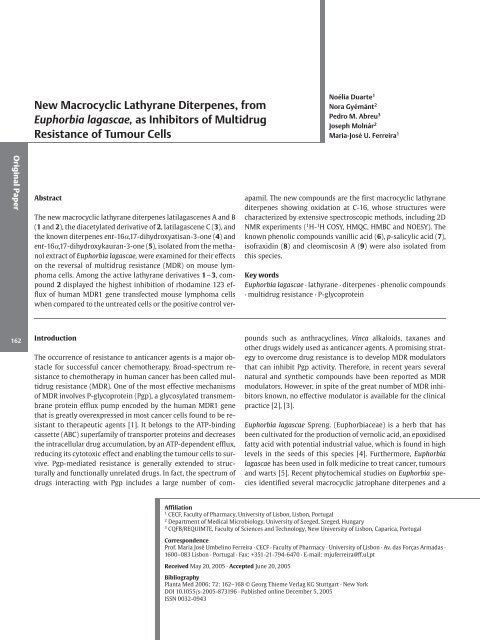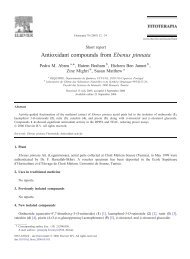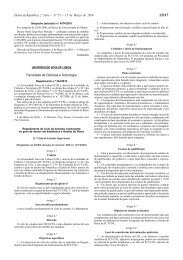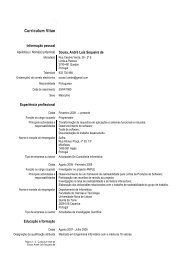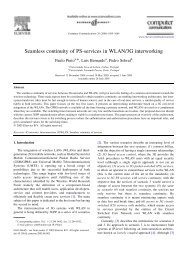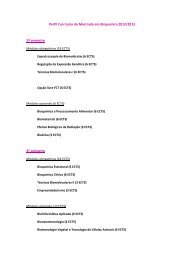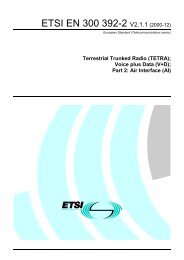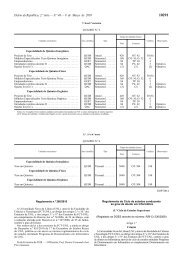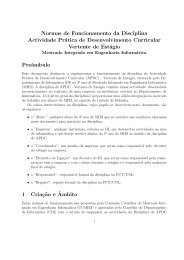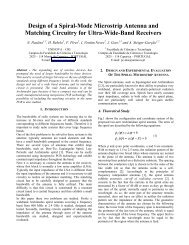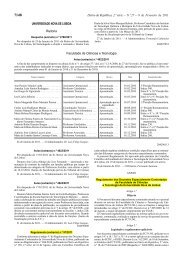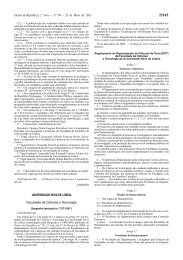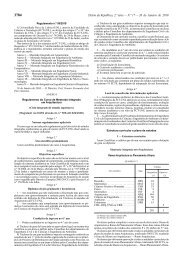New Macrocyclic Lathyrane Diterpenes, from Euphorbia lagascae ...
New Macrocyclic Lathyrane Diterpenes, from Euphorbia lagascae ...
New Macrocyclic Lathyrane Diterpenes, from Euphorbia lagascae ...
You also want an ePaper? Increase the reach of your titles
YUMPU automatically turns print PDFs into web optimized ePapers that Google loves.
<strong>New</strong> <strong>Macrocyclic</strong> <strong>Lathyrane</strong> <strong>Diterpenes</strong>, <strong>from</strong><br />
<strong>Euphorbia</strong> <strong>lagascae</strong>, as Inhibitors of Multidrug<br />
Resistance of Tumour Cells<br />
NoØlia Duarte 1<br />
Nora GyØmµnt 2<br />
Pedro M. Abreu 3<br />
Joseph Molnµr 2<br />
Maria-JosØ U. Ferreira 1<br />
Original Paper<br />
Abstract<br />
The new macrocyclic lathyrane diterpenes latilagascenes A and B<br />
(1 and 2), the diacetylated derivative of 2, latilagascene C (3), and<br />
the known diterpenes ent-16a,17-dihydroxyatisan-3-one (4) and<br />
ent-16a,17-dihydroxykauran-3-one (5), isolated <strong>from</strong> the methanol<br />
extract of <strong>Euphorbia</strong> <strong>lagascae</strong>, were examined for their effects<br />
on the reversal of multidrug resistance (MDR) on mouse lymphoma<br />
cells. Among the active lathyrane derivatives 1 ± 3, compound<br />
2 displayed the highest inhibition of rhodamine 123 efflux<br />
of human MDR1 gene transfected mouse lymphoma cells<br />
when compared to the untreated cells or the positive control verapamil.<br />
The new compounds are the first macrocyclic lathyrane<br />
diterpenes showing oxidation at C-16, whose structures were<br />
characterized by extensive spectroscopic methods, including 2D<br />
NMR experiments ( 1 H- 1 H COSY, HMQC, HMBC and NOESY). The<br />
known phenolic compounds vanillic acid (6), p-salicylic acid (7),<br />
isofraxidin (8) and cleomiscosin A (9) were also isolated <strong>from</strong><br />
this species.<br />
Key words<br />
<strong>Euphorbia</strong> <strong>lagascae</strong> ´ lathyrane ´ diterpenes ´ phenolic compounds<br />
´ multidrug resistance ´ P-glycoprotein<br />
162<br />
Introduction<br />
The occurrence of resistance to anticancer agents is a major obstacle<br />
for successful cancer chemotherapy. Broad-spectrum resistance<br />
to chemotherapy in human cancer has been called multidrug<br />
resistance (MDR). One of the most effective mechanisms<br />
of MDR involves P-glycoprotein (Pgp), a glycosylated transmembrane<br />
protein efflux pump encoded by the human MDR1 gene<br />
that is greatly overexpressed in most cancer cells found to be resistant<br />
to therapeutic agents [1]. It belongs to the ATP-binding<br />
cassette (ABC) superfamily of transporter proteins and decreases<br />
the intracellular drug accumulation, by an ATP-dependent efflux,<br />
reducing its cytotoxic effect and enabling the tumour cells to survive.<br />
Pgp-mediated resistance is generally extended to structurally<br />
and functionally unrelated drugs. In fact, the spectrum of<br />
drugs interacting with Pgp includes a large number of compounds<br />
such as anthracyclines, Vinca alkaloids, taxanes and<br />
other drugs widely used as anticancer agents. A promising strategy<br />
to overcome drug resistance is to develop MDR modulators<br />
that can inhibit Pgp activity. Therefore, in recent years several<br />
natural and synthetic compounds have been reported as MDR<br />
modulators. However, in spite of the great number of MDR inhibitors<br />
known, no effective modulator is available for the clinical<br />
practice [2], [3].<br />
<strong>Euphorbia</strong> <strong>lagascae</strong> Spreng. (<strong>Euphorbia</strong>ceae) is a herb that has<br />
been cultivated for the production of vernolic acid, an epoxidised<br />
fatty acid with potential industrial value, which is found in high<br />
levels in the seeds of this species [4]. Furthermore, <strong>Euphorbia</strong><br />
<strong>lagascae</strong> has been used in folk medicine to treat cancer, tumours<br />
and warts [5]. Recent phytochemical studies on <strong>Euphorbia</strong> species<br />
identified several macrocyclic jatrophane diterpenes and a<br />
Affiliation<br />
1 CECF, Faculty of Pharmacy, University of Lisbon, Lisbon, Portugal<br />
2 Department of Medical Microbiology, University of Szeged, Szeged, Hungary<br />
3 CQFB/REQUIMTE, Faculty of Sciences and Technology, <strong>New</strong> University of Lisbon, Caparica, Portugal<br />
Correspondence<br />
Prof. Maria JosØ Umbelino Ferreira ´ CECF ´ Faculty of Pharmacy ´ University of Lisbon ´ Av. das ForcË as Armadas ´<br />
1600±083 Lisbon ´ Portugal ´ Fax: +351-21-794-6470 ´ E-mail: mjuferreira@ff.ul.pt<br />
Received May 20, 2005 ´ Accepted June 20, 2005<br />
Bibliography<br />
Planta Med 2006; 72: 162±168 Georg Thieme Verlag KG Stuttgart ´ <strong>New</strong> York<br />
DOI 10.1055/s-2005-873196 ´ Published online December 5, 2005<br />
ISSN 0032-0943
lathyrane-type diterpenoid as powerful Pgp inhibitors [6], [7],<br />
[8], [9]. The purpose of the present study was to search for new<br />
novel MDR modulators <strong>from</strong> <strong>Euphorbia</strong> <strong>lagascae</strong>.<br />
Materials and Methods<br />
General experimental procedures<br />
Melting points were determined on a Köffler apparatus and are<br />
uncorrected. Optical rotations were obtained using a Perkin Elmer<br />
241 polarimeter. IR spectra were determined on an FTIR Nicolet<br />
Impact 400, and NMR spectra were recorded on a Bruker<br />
ARX-400 NMR spectrometer ( 1 H 400 MHz; 13 C 100.61 MHz),<br />
using CDCl 3 , MeOD or C 5 D 6 N as solvents. MS were taken on a Kratos<br />
MS25RF spectrometer (70 eV) and HR-MS and HR-SIMS on a<br />
Micromass Autospec spectrometer. Column chromatography<br />
was carried out on SiO 2 (Merck 9385). TLC were performed on<br />
precoated SiO 2 F 254 plates (Merck 5554 and 5744) and visualized<br />
under UV light and by spraying with sulphuric acid-acetic acidwater<br />
(1 : 20:4) or sulphuric acid-water (1 :1) followed by heating.<br />
HPLC was carried out on a Merck-Hitachi instrument, with<br />
UV detection (254 nm), using a Merck LiChrospher 100 RP-18<br />
(10 mm, 250 ”10 mm) column.<br />
Plant material<br />
<strong>Euphorbia</strong> <strong>lagascae</strong> Spreng. was collected in Cova da Beira, Coimbra,<br />
Portugal, and identified by Dr. Teresa Vasconcelos of Instituto<br />
Superior de Agronomia, University of Lisbon. A voucher specimen<br />
(No. 323) has been deposited at the herbarium of Instituto<br />
Superior de Agronomia.<br />
Extraction and isolation<br />
The air-dried powdered plant (5.9 kg) was extracted with methanol<br />
(6 ” 12 L) at room temperature. Evaporation of the solvent<br />
(under vacuum, 40 8C) <strong>from</strong> the crude extract yielded a residue<br />
of 284 g which was suspended in boiling MeOH and frozen, to<br />
give a precipitate (55 g) consisting mainly of waxes, that was<br />
eliminated by filtration. The filtrate was evaporated, and the residue<br />
(233 g) resuspended in a MeOH/H 2 O solution (1 :2, 3 L),<br />
and extracted with Et 2 O (6 ”2 L). The ether extract was dried<br />
(Na 2 SO 4 ) and evaporated under vacuum (40 8C), yielding a residue<br />
(68.3 g) that was chromatographed over SiO 2 (8 ”120 cm, 2<br />
kg), using mixtures of n-hexane/EtOAc (1 : 0, 4 L; 19 : 1 to 7: 3,<br />
5 % gradient, 2.5 L each eluent; 13 :7 to 1:9, 5 % gradient, 1 L<br />
each eluent; 0 :1, 8 L) and EtOAc/MeOH (19 : 1 to 17: 5, 5 % gradient,<br />
1 L each eluent; 4 : 1 to 1 : 4, 10% gradient, 1 L each eluent) as<br />
eluting solvents. The more apolar crude fractions containing<br />
mainly waxes and triterpenes were discarded. The residue (7 g)<br />
of the polar crude fraction eluted with EtOAc (8 L) was subjected<br />
to CC on SiO 2 (5 ”80 cm, 250 g) with mixtures of n-hexane/EtOAc<br />
(1 :1, 2 L; 2 : 3 to 0:1, 10 % gradient, 1 L each eluent) and EtOAc/<br />
MeOH (19 : 1 to 4 : 1, 10 % gradient, 0.5 L each eluent; 1 : 1, 0.5 L).<br />
After TLC monitoring the column chromatographic fractions<br />
were combined into four fractions (F A to F D ).<br />
The residue (1.55 g) of fraction F A (n-hexane/ EtOAc 1 : 1, 2 L) was<br />
submitted to CC (3 ”80 cm, 80 g SiO 2 ; n-hexane/ EtOAc; 9 :1 and<br />
4 :1, 0.5 L each eluent; 7:3 and 3:2, 0.75 L; 1 : 1 and 2 : 3, 0.5 L;<br />
3 :7 and 1 :4, 0.25 L and 1 :9, 0.5 L). Fractions eluted with n-hexane/EtOAc<br />
(7:3 to 1 : 1, 2 L) were associated (733 mg) and further<br />
rechromatographed by CC (2”50 cm, 60 g SiO 2 , n-hexane/CH 2 Cl 2 ,<br />
1 :9, 0.25 L; 0:1, 0.4 L and CH 2 Cl 2 /MeOH, 99 :1, 0.45 L; 39 :1, 0.75<br />
L;19 : 1, 0.3 L; 9 :1, 0.3 L). Solvent evaporation <strong>from</strong> fractions<br />
eluted with n-hexane/CH 2 Cl 2 (1 :9 and 0:1, 0.65 L) gave a mixture<br />
(100 mg) that was purified by preparative TLC (CHCl 3 /<br />
MeOH, 19 :1) yielding 7.2 mg of compound 8 (R f = 0.3, CHCl 3 /<br />
MeOH, 19 : 1), and 7 mg of a compound with a strong absorption<br />
at 254 nm, that was further purified by HPLC (MeOH/H 2 O, 3 : 1, 4<br />
mL/min) to afford 4 mg of compound 1 (R t = 16 min; R f = 0.66,<br />
CHCl 3 /MeOH, 19 : 1). Fractions eluted with CH 2 Cl 2 /MeOH (39 : 1,<br />
0.75 L) were associated, and the residue (160 mg) chromatographed<br />
on preparative TLC (CHCl 3 /MeOH, 9:1, 2 ”) to yield<br />
35 mg of compound 6 (R f = 0.34, CHCl 3 /MeOH, 9 :1), and 10 mg<br />
of compound 7 (R f = 0.25, CHCl 3 /MeOH, 9 :1).<br />
Fraction F B eluted with n-hexane/EtOAc (2 :3, 1 L, 1.65 g) was<br />
submitted to CC (3 ”80 cm, 100 g SiO 2 ; n-hexane/EtOAc; 7:3, 1<br />
L; 3:2 and 1 :1, 0.5 L each eluent, 2 :3 and 3 : 7, 1 L each; 1 : 4<br />
and 0:1 0.5 L each eluent and EtOAc/MeOH 19 :1 to 9 :1, 5 % gradient,<br />
0.5 L each eluent). Fractions eluted with n-hexane/EtOAc<br />
were pooled, and the mixture (1 g) rechromatographed twice by<br />
CC (2 ”50 cm, 60 g SiO 2 ) using mixtures of n-hexane/CH 2 Cl 2 (1 : 9,<br />
0.2 L; 0:1, 0.25 L) and CH 2 Cl 2 /MeOH (99 :1, 0.25 L, 49:1, 0.75 L;<br />
19 :1, 0.25 L). The residue of the fractions eluted with CH 2 Cl 2 /<br />
MeOH (49 :1 and 19 : 1, 1 L, 490 mg) was rechromatographed<br />
twice by CC as above, yielding 162 mg of a compound that was<br />
further purified by recrystallisation (CH 2 Cl 2 /n-hexane), affording<br />
126 mg of compound 4 (R f = 0.37, CHCl 3 /MeOH, 19 : 1).<br />
Fraction F C eluted with n-hexane/EtOAc (3:7, 1 L and 1 : 4, 1 L,<br />
2.26 g) was submitted to CC (3 ”80 cm, 150 g SiO 2 ; n-hexane/<br />
CH 2 Cl 2 , 1:1 to 0:1, 10 % gradient, 0.5 L each eluent; and CH 2 Cl 2 /<br />
MeOH, 49 : 1, 0.5 L;19 :1, 1.5 L; 9 :1, 0.5 L; 17: 1, 0.3 L). The mixture<br />
(1.5 g) of the fractions eluted with CH 2 Cl 2 /MeOH (19 : 1, 1.5 L) was<br />
further rechromatographed by CC (2”50 cm, 70 g SiO 2 ; n-hexane/EtOAc;<br />
2 :3, 1.2 L; 1:7, 0.9 L, 1 :4, 0.6 L, 0:1, 0.3 L and<br />
EtOAc/MeOH 49 :1, 0.3 L). Solvent evaporation of fractions eluted<br />
with n-hexane/EtOAc (2 :3 and 3:7, 2.1 L, 917 mg) gave a mixture<br />
that was subject to CC (2 ”50 cm, 60 g SiO 2 ; n-hexane/CH 2 Cl 2 ,<br />
1 :9, 0.6 L; 0 :1, 0.3 L and CH 2 Cl 2 /MeOH, 99 :1, 0.9 L, 97:3, 0.9 L;<br />
19 :1, 0.3 L). Fractions eluted with CH 2 Cl 2 /MeOH (99 :1) were<br />
associated and the residue (140 mg) rechromatographed by CC<br />
as above, yielding 40 mg of a compound that was crystallised<br />
<strong>from</strong> MeOH, to afford 16 mg of compound 9 (R f = 0.6, CHCl 3 /<br />
MeOH, 17: 3). Fractions eluted with CH 2 Cl 2 /MeOH, 97: 3 and<br />
19 :1 (1.2 L, 601.2 mg), were rechromatographed as above, affording<br />
500 mg of an impure compound that was then purified<br />
by HPLC (MeCN/H 2 O, 11 :9, 5 mL/min, 254 nm), yielding 287 mg<br />
of compound 2(R t = 13 min; R f = 0.5, CHCl 3 /MeOH, 17:3). Purification<br />
of the compound with R t = 6 min (20 mg) by preparative<br />
TLC (CHCl 3 /MeOH, 9:1, 2 ”) afforded 10 mg of compound 5<br />
(R f = 0.4, CHCl 3 /MeOH, 9 :1).<br />
Latilagascene A [(2R*,3S*,4R*,5R*,6R*,9S*,11S*,15R*)-16-acetoxy-<br />
15b-cinnamoyloxy-5a,6b-epoxy-3b-hydroxy-14-oxolathyr-12Eene,<br />
1]: oil; [a] D 25 : ±113.08 (CHCl 3 , c 0.1); HR-MS: m/z = 522.2615<br />
[M] + , (calcd. for C 31 H 38 O 7 : 522.2617); IR (film): n max = 3411, 2922,<br />
2855, 1730, 1714, 1652, 1640, 1452, 1257, 1041, 853 cm ±1 ; EI-MS:<br />
m/z (rel. int) = 522 [M] + (< 1), 504 [M ±H 2 O] + (< 1), 391 [M ±<br />
C 9 H 7 O] + (1), 331 [M±C 9 H 7 O±CH 3 COOH] + (1) 313 [M ± C 9 H 7 O±<br />
Original Paper<br />
163<br />
Duarte N et al. <strong>New</strong> <strong>Macrocyclic</strong> <strong>Lathyrane</strong> ¼ Planta Med 2006; 72: 162 ±168
Original Paper<br />
CH 3 COOH ± H 2 O] + (1) 289 (7), 149 (24), 147 (31), 131 [C 9 H 7 O] +<br />
(89), 103 (34), 69 (48), 57 (81), 55 (56), 43 (100); 1 H- and 13 C-<br />
NMR see Table 1.<br />
Latilagascene B [(2R*,3S*,4R*,5R*,6R*,9S*,11S*,15R*)-15b-cinnamoyloxy-5a,6b-epoxy-3b,16-dihydroxy-14-oxolathyr-12E-ene,<br />
2]: White amorphous solid; [a] 25 D : ±168.078 (CHCl 3 , c 0.1); HR-<br />
SIMS: m/z = 481.2583 [M + 1] + , (calcd. for C 29 H 36 O 6: 481.2590);<br />
IR (KBr): n max = 3425, 2919, 2855, 1715, 1633, 1653, 1448, 1258,<br />
1165, 1117, 853, 767, 730, cm ±1 ; FAB-MS: m/z (rel. int) = 503 [M<br />
+ Na] + (13), 481 [M + 1] + (1), 355 [M + Na ± C 9 H 8 O 2 ] + (1), 315 (1),<br />
131 (100), 121 (10), 103 (26), 89 (20), 77 (34); 1 H- and 13 C-NMR<br />
see Table 2.<br />
Acetylation of compound 2: Compound 2 (50 mg) was suspended<br />
in Ac 2 O (1 mL) and pyridine (1 mL). After stirring at room temperature<br />
for 48 hours, the reaction was worked up as usual,<br />
yielding 40 mg of compound 3 (R f = 0.64, CHCl 3 /MeOH, 19 : 1).<br />
Latilagascene C [(2R*,3S*,4R*,5R*,6R*,9S*,11S*,15R*)-3b,16-diacetoxy-15b-cinnamoyloxy-5a,6b-epoxy-14-oxolathyr-12E-ene,<br />
3]:<br />
oil; [a] D 25 : ±130.438 (CHCl 3 , c 0.1); IR (film): n max = 2923, 2854,<br />
1740, 1717, 1660, 1631, 1454, 1368, 1234, 1167, 1141, 1038, 855,<br />
763 cm ±1 ; EIMS: m/z (rel. int) = 564 [M] + (< 1), 433 [M ±<br />
C 9 H 8 O 2 ] + (4), 131 (96), 103 (48), 93 (22), 84 (25), 77 (26), 43<br />
(100); 1 H- and 13 C-NMR see Table 2.<br />
Assay for MDR reversal effect<br />
Cells: The L5178 Y mouse T-lymphoma parental cell line was<br />
transfected with the pHa MDR1/A retrovirus as previously described<br />
[10]. The L5178 MDR cell line and the L5178 Y parental<br />
cell line (obtained <strong>from</strong> Prof. M. Gottesmann, NCI and FDA,<br />
USA), were grown in McCoy's 5A medium with 10% heat-inactivated<br />
horse serum, D-glutamine and antibiotics. MDR1-expressing<br />
cell lines were selected by culturing the infected cells with<br />
60 ng/mL colchicine to maintain expression of the MDR phenotype.<br />
Cell viability was determined by trypan blue.<br />
Table 1<br />
NMR data of compound 1 (J in Hz)<br />
Position 1 H 13 C DEPT HMBC (C®H) NOESY<br />
164<br />
1a 3.48 dd (7.6; 13.3) 39.8 CH 2 ± H-1b,H-4<br />
1b 1.79t (13.3) ± ± ± H-1a, H-16a, 3-OH<br />
2 2.16 m 44.3 CH 1b, 16a H-1a, H-3, H-4<br />
3 4.16 br s 74.7 CH 1a, 16a, 16b H-2, H-4,<br />
4 1.54 dd (3.7; 9.4) 51.7 CH 1a,5 H-1a, H-2, H-3, Me-17<br />
5 3.66 d (9.4) 58.0 CH 7a,4,17 H-7b/8b, H-12, 16-Oac, H-3¢<br />
6 ± 63.9C 17 ±<br />
7a* 2.03 m 38.7 CH 2 17, 9H-7b/8b<br />
7b** 1.56 m ± ± H-7a/8a<br />
8a* 2.03 m 23.3 CH 2 9H-7b/8b<br />
8b** 1.56 m ± ± H-7a/8a<br />
91.14 m 33.9CH 18, 19H-7a/8a, H-11, Me-20<br />
10 ± 26.4 C 9, 18, 19 ±<br />
11 1.49 dd (7.9; 11.0) 29.8 CH 18, 19 H-7a/8a, H-9, Me-20<br />
12 7.02 brd (11.0) 144.7 CH 20 H-5, H-7b/8b, H-19<br />
13 ± 133.9C 20 ±<br />
14 ± 194.8 C 1a, 12, 20 ±<br />
15 ± 91.2 C 1a,1b ±<br />
16a 4.48 dd (10.8; 11.2) 62.8 CH 2 1b H-1b, H-16b, 16-OAc<br />
16b 3.99 dd (4.7; 11.2) H-2, H-16a<br />
17 1.17 s 20.0 CH 3 ± H-4, H-7a/8a,<br />
18 1.10 s 29.0 CH 3 9, 11, 19 H-9, H-11<br />
190.85 s 16.2 CH 3 18 H-12, H-2¢<br />
20 1.87 s 12.3 CH 3 12 H-9, H-11<br />
3-OH 3.09brs ± ± ± H-1b<br />
15-OCin<br />
1¢ ± 165.6 C 3¢<br />
2¢ 6.45 d (16.0) 117.3 CH 3¢ Me-19, H-3¢, H-5¢,H-6¢, H-7¢,H-8¢, H-9¢<br />
3¢ 7.69d (16.0) 146.7 CH 5¢,9¢ H-2¢,H-5<br />
4¢ ± 133.9C 2¢,5¢,6¢,8¢,9¢<br />
5¢,9¢ 7.47 m 128.2 CH 3¢,5¢,6¢,8¢,7¢,9¢ H-2¢<br />
6¢,8¢ 7.38 m 130.8 CH 5¢,9¢ H-2¢<br />
7¢ 7.38 m 129.0 CH 5¢,9¢ H-2¢<br />
16-OAc 2.06 s 172.2 C 16a, 16b, OAc H-5, H-16<br />
20.9CH 3 ±<br />
*, ** Overlapped signals.<br />
Duarte N et al. <strong>New</strong> <strong>Macrocyclic</strong> <strong>Lathyrane</strong>¼ Planta Med 2006; 72 162 ± 168
Table 2<br />
NMR data of compound 2 and 3 (J in Hz)<br />
Position 2 3<br />
1 H 13 C HMBC (C®H) NOESY 1 H 13 C<br />
1a 3.42 dd (7.4; 13.3) 39.3 ± H-1b, H-2 3.62 dd (7.6; 13.6) 41.0<br />
1b 1.91 t (13.2) ± ± H-1a, H-2 1.55 m ±<br />
2 2.04 m 45.5 ± H-1a, H-3, H-4, H-16a 2.41 m 42.4<br />
3 4.44 br s 76.4 1a H-2, H-4 5.61 t (3.6) 76.6<br />
4 1.53 dd (3.5; 9.3) 51.9 1a, 5 H-2, H-3, H-7a, H-12, Me-17 1.72 dd (3.9; 9.1) 50.8<br />
5 3.65 d (9.4) 58.4 4, 17 ± 3.32 d (9.2) 57.0<br />
6 ± 64.4 5, 7a, 17 ± ± 63.4<br />
7a 2.04 m 38.6 9, 17 H-4, H-7b, Me-17 2.03 m 38.4<br />
7b 1.59m ± H-7a 1.74 m<br />
8a 2.01 m 23.2 ± ± 2.06 m 23.4<br />
8b 1.57 m 1.55 m<br />
91.12 m 33.8 18, 19 H-11, H-3¢,H-5¢,H-6¢,H-7¢,H-8¢,H-9¢ 1.14 m 34.0<br />
10 ± 26.4 9, 18, 19 ± ± 26.5<br />
11 1.46, dd(7.8; 10.7) 29.7 9, 19 H-9, Me-20, H-6¢,H-7¢, H-8¢ 1.49, dd (7.9, 10.9) 29.8<br />
12 6.98 d (10.9) 144.6 20 H-4, Me-19 7.00 d (11.1) 144.9<br />
13 ± 133.920 ± ± 133.9<br />
14 ± 195.1 1a, 1b, 4, 12, 20 ± ± 194.3<br />
15 ± 91.6 1a, 1b ± ± 90.9<br />
16a 3.85 dd (4.0; 11.0) 61.2 1b, 2 H-2 4.13 dd (8.7; 11.0) 62.3<br />
16b 3.80 dd (7.4; 11.0) 3.97 dd (6.3; 11.1)<br />
17 1.16 s 19.3 ± H-4, H-7a,H-3¢, H-5¢,H-9¢ 1.16 s 19.9<br />
18 1.08s 29.0 11, 19 Me-19 1.11 s 29.0<br />
190.82 s 16.2 9, 18 H-12, Me-18 0.86 s 16.2<br />
20 1.85 s 12.3 ± H-11 1.88 s 12.3<br />
15-OCin<br />
1¢ ± 165.6 2¢,3¢ ± 165.4<br />
2¢ 6.44 d (16.0) 117.3 ± H-3¢,H-5¢,H-9¢ 6.43 d (16.0) 117.0<br />
3¢ 7.65 d (16.0) 146.5 5¢,9¢ H-2¢,H-5¢,H-9¢, H-9, Me-17 7.71 d (16.0) 147.0<br />
4¢ ± 133.92¢,6¢,8¢ ± 133.8<br />
5¢,9¢ 7.45 m 128.1 3¢,6¢,7¢,8¢ H-2¢,H-3¢, H-9, Me-17 7.49 m 128.4<br />
6¢,8¢ 7.35 m 130.6 5¢,9¢ H-9, H-11 7.41 m 130.9<br />
7¢ 7.35 m 128.9 ± H-9, H-11 7.41 m 129.0<br />
3-OAc ± ± ± ± 2.15* 170.9*<br />
20.8<br />
16-OAc ± ± ± ± 2.01* 169.1*<br />
20.8<br />
Original Paper<br />
165<br />
* Interchangeable values.<br />
Assay for rhodamine 123 accumulation test: The harvested cells<br />
were resuspended in serum-free McCoy's 5A medium and distributed<br />
into Eppendorf tubes at the density of 2 ”10 6 cell/mL.<br />
Then, 2 to 20 mL of the stock solution (1 mg/mL in DMSO) of the<br />
tested compounds were added and the samples were incubated<br />
for 10 min at room temperature. Following the addition of 10 mL<br />
of rhodamine 123 to the samples (5.5 mM final concentration),<br />
the cells were further incubated for 20 min at 37 8C, washed<br />
twice, and resuspended in 0.5 mL phosphate-buffered saline<br />
(PBS) for analysis. The fluorescence uptake of the cells was measured<br />
by flow cytometry using a Beckton Dickinson FACScan instrument<br />
equipped with an argon laser. The fluorescence excitation<br />
and emission wavelengths were 488 nm and 520 nm,<br />
respectively. Verapamil was used as a positive control, and the<br />
influence of DMSO on the cells was monitored. The mean fluorescence<br />
intensity was calculated as a percentage of the control<br />
for the parental (PAR) and MDR cell lines as compared to untreated<br />
cells. An activity ratio (R) was calculated on the basis of<br />
the measured fluorescence values (FL-1) measured via the following<br />
equation [11], [12].<br />
R = (FL ± 1 MDRtreated /FL ± 1 MDRcontrol )/(FL ± 1 parentaltreated /FL ± 1 parentalcontrol)<br />
Results and Discussion<br />
The Et 2 O-soluble fraction of the methanol extract of the aerial<br />
air-dried powdered plant of <strong>Euphorbia</strong> <strong>lagascae</strong> was submitted<br />
to successive chromatographic fractionation and purification, as<br />
described in the Materials and Methods section, to afford the<br />
new diterpenes 1 and 2 along with the known compounds ent-<br />
16a,17-dihydroxyatisan-3-one (4), ent-16a,17-dihydroxykauran-<br />
3-one (5), vanillic acid (6), p-salicylic acid (7), isofraxidin (8), and<br />
Duarte N et al. <strong>New</strong> <strong>Macrocyclic</strong> <strong>Lathyrane</strong> ¼ Planta Med 2006; 72: 162 ±168
Original Paper<br />
166<br />
cleomiscosin A (9). Acetylation of 2 yielded the diacetylated derivative<br />
3.<br />
Compound 1 was obtained as an oil, whose molecular formula<br />
was determined as C 31 H 38 O 7 <strong>from</strong> its HR-MS, which showed a<br />
molecular ion at 522.2615, indicative of thirteen unsaturations.<br />
In the IR spectrum, characteristic absorption bands for ester carbonyl<br />
groups, an a,b-unsaturated ketone, and a hydroxy group<br />
were observed. The EI-MS of 1 displayed a strong (89 %) peak at<br />
m/z =131[C 9 H 7 CO] + and a ion at 391 [M ± C 9 H 7 O] + suggesting<br />
the existence of a cinnamoyl group whose presence was also deduced<br />
<strong>from</strong> the 1 H- (d = 7.38±7.47, 5H; 6.45 and 7.69 doublets,<br />
J = 16.0 Hz) and 13 C-NMR spectra (d C = 133.9, 2 ”130.8, 129.0,<br />
2 ”128.2, aromatic ring; 146.7, 117.3, olefinic carbons; 165.6 carbonyl).<br />
Besides, the EI-MS showed ions at m/z = 331 [M±<br />
C 9 H 7 O±CH 3 COOH ] + and 313 [M ± C 9 H 7 O±CH 3 COOH±H 2 O] + resulting<br />
<strong>from</strong> the sequential loss of one acetoxy group and one hydroxy<br />
group. These structural features were also confirmed by<br />
the NMR spectral data of 1, which revealed the presence of one<br />
acetyl group (d = 2.06, d C = 172.2), and a proton signal at<br />
d = 3.09 without correlation in the HMQC spectrum (Table 1).<br />
Moreover, the 1 H NMR spectrum of 1 showed signals for four tertiary<br />
methyl groups (d = 1.87, 1.17, 1.10, 0.85), two methine protons<br />
(d = 4.16, brs; 3.66, d, J = 9.4 Hz) and one diastereotopic<br />
methylene group (d = 4.48, dd, J = 10.8, 11.2 Hz and d = 3.99<br />
dd, J = 4.7, 11.2 Hz) bearing oxygen, and one olefinic proton at<br />
d = 7.02 (brd, J = 11.0 Hz). Besides the signals of the acyl groups,<br />
the remaining 13 C-NMR and DEPT spectral data showed resonances<br />
of twenty carbons corresponding to four CH 3 , four CH 2 (one<br />
oxygen bearing carbon at d C = 62.8), seven CH (two oxygenated<br />
at d C = 58.0 and 74.7 and one sp 2 at 144.7) and five quaternary<br />
carbons (a carbonyl group at d C = 194.8, one olefinic carbon at<br />
133.9 and two oxygenated carbon at 63.9 and 91.2). The relatively<br />
high-field carbonyl signal (d C = 194.8) and the existence of a<br />
remarkable downfield shifted vinylic proton signal at d = 7.02<br />
were consistent with an enone system in the molecule. The<br />
gem-dimethyl-substituted cyclopropane ring was indicated by a<br />
pair of highfield methine signals (d = 1.14 and 1.49) associated to<br />
a quaternary carbon at d C = 26.4. Furthermore, an oxacyclopropane<br />
ring was evidenced by the chemical shifts of the oxygenated<br />
carbons at d C = 58.0 (CH) and 63.9 (C) and the lowfield methine<br />
proton at d = 3.66. The above structural features, mainly<br />
the presence of a cyclopropane ring, pointed to a lathyrane skeleton<br />
(C 20 H 30 O 5 ) for 1. Further structural details were obtained by<br />
2D NMR measurements (COSY, HMQC and HMBC), which allowed<br />
the assignment of the remaining NMR resonances. The<br />
1 H- 1 HCOSY( 3 J couplings) and HMQC experiments revealed the<br />
structure of two sequences of correlated protons: -CH 2 -<br />
CH(CH 2 OR)-CH(OR)-CH(R)-CH(OR)- (A); -CH 2 -CH 2 -CH(R)-CH(R)-<br />
CH = C(C)- (B). The location of the olefinic methyl group<br />
(d = 1.87, Me-20) in fragment B was deduced <strong>from</strong> its 4 J H-H coupling<br />
with the vinylic proton at d = 7.02 (H-12). Furthermore, the<br />
heteronuclear 2 J C-H and 3 J C-H connectivities displayed in the<br />
HMBC spectrum of 1 (see Table 1), between the quaternary carbons<br />
and the protons of the A and B spin systems, allowed the<br />
linkage of the referred fragments, the assignment of an epoxy<br />
ring at C-5/C-6, and a ketone group at C-14 (d C = 194.8), as well<br />
as the establishment of the cyclopropane ring. The 3 J C-H HMBC<br />
correlations also led to the location of two ester functions. The<br />
ester carbonyl carbon at d C = 172.2 is bound to C-16 since it correlates<br />
with the methylenic protons at d = 3.99 and 4.48, and the<br />
acetyl methyl group at d = 2.06. The placement of the second<br />
acyl group (d = 6.45 ± 7.38, d C = 165.6) on the quaternary carbon<br />
C-15 (d C = 91.2) followed <strong>from</strong> the observed 2 J C-H correlation<br />
with a vinylic proton (d = 7.69) of the cinnamoyl group, and the<br />
absence of 3 J C-H correlation with the oxymethine protons. Evidence<br />
for the location of the hydroxy group at C-3, was provided<br />
by the lack of any correlation of H-3 with the carbonyl carbons.<br />
The relative stereochemistry of 1 was deduced <strong>from</strong> the NOESY<br />
spectrum. The strong nuclear Overhauser interactions of the a-<br />
oriented H-4, taken as a reference point on a biogenetic basis<br />
[13], with H-3, H-2, H-1a, indicated the a orientation for these<br />
three protons. Further cross peaks between H-1b and H-16a, H-<br />
5 and H-3, and H-5/16-OAc confirmed the stereochemistry at C-<br />
2, and established the configuration at C-5 and C-15, as well as<br />
the trans A/B ring junction. Besides, H-5 also exhibited a nuclear<br />
Overhauser effect at H-12, thus suggesting that this proton is oriented<br />
above the plane of the macrocycle. The NOE enhancements<br />
of H-12 at Me-19, H-11 at Me-18, and H-9 at Me-18, indicated<br />
that H-9 and H-11 have the same a configuration, and<br />
thereby a cis macrocycle/cycloprane ring connection. Moreover,<br />
the E configuration of the C-12/C-13 double bond was deduced<br />
<strong>from</strong> the observed cross peaks between H-9/Me-20 and H-11/<br />
Me-20, that evidenced the orientation of Me-20 below the plane<br />
of the molecule. The absence of NOE correlations between H-5/<br />
Me-17, and the NOE effect observed between Me-17 and H-4 indicated<br />
the a configuration of Me-17. All the above data are in<br />
agreement with structure 1, corresponding to a new lathyrane<br />
diterpene, named as latilagascene A. Although a great number<br />
of highly oxidised macrocyclic lathyrane and jatrophane diterpenes<br />
has been previously isolated <strong>from</strong> <strong>Euphorbia</strong> species, this<br />
is the first reported occurrence of a related derivative oxidised<br />
at C-16. <strong>Lathyrane</strong> derivatives containing the rare 5,6-epoxy<br />
function were previously found in the structure of jolkinol [14],<br />
[15]. A similar derivative was recently isolated <strong>from</strong> E. villosa [16].<br />
Compound 2 was obtained as a white amorphous powder. Its<br />
molecular formula was established by HR-SIMS, whose spectrum<br />
showed a quasi-molecular ion at m/z = 481.2583 [M + H] + . The<br />
UV, MS and NMR data of 2 clearly resemble those found for lati-<br />
Duarte N et al. <strong>New</strong> <strong>Macrocyclic</strong> <strong>Lathyrane</strong>¼ Planta Med 2006; 72 162 ± 168
lagascene A (1). As for that compound, the base peak at m/z =<br />
131 [C 9 H 7 CO] + displayed by the FAB-MS, and its NMR data also<br />
indicated the presence of the cinammate ester (d = 7.35± 7.45,<br />
5H; 6.44 and 7.65 doublets, J = 16.0 Hz; d C = 133.9, 2 ”130.6,<br />
128.9, 2”128.1, 146.5, 117.3 and 165.6), and the same number of<br />
protons bounded to oxygenated carbons (d = 4.44, 1H, brs; 3.85,<br />
1H, dd, J = 4.0, 11.0 Hz and 3.80, 1H, dd, J = 7.4, 11.0 Hz; 3.65, 1H,<br />
d, J = 9.4 Hz), although there was no evidence for the presence of<br />
acetyl resonances (see Table 2). In addition to the cinnamoyl<br />
group, the 13 C-NMR spectrum of 2 also evidenced two methines<br />
(d C = 76.4, 58.4), one methylene (d C = 61.2), two quaternary carbon<br />
linked to oxygen (d C = 64.4, 91.6), a ketone (d C = 195.1), and<br />
two vinylic carbons (d C = 144.6, CH; 133.9, C). The above data<br />
suggest that, in comparison with latilagascene A, compound 2<br />
bears another free hydroxy group, which was located at C-16 on<br />
the basis of observed differences in carbon and proton chemical<br />
shifts for both compounds. The diamagnetic effect of 1.6 ppm at<br />
C-1 (a-carbon), and the downfield shift of 1.2 ppm at C-2 (b-carbon)<br />
observed for compound 2 relatively to 1, are in agreement<br />
with the effects expected for the substitution of an acetoxy by a<br />
hydroxy group. The clear deshielding of C-3 (1.7 ppm; g carbon)<br />
may be due to intramolecular hydrogen bonding between the<br />
hydroxy groups at C-16 and C-3, which also corroborates the existence<br />
of free hydroxy groups at these positions. The above data<br />
confirmed compound 2 as a new lathyrane diterpene, named as<br />
latilagascene B.<br />
Table 3<br />
Compound<br />
Effect of compounds 1±5 a on reversal of multidrug resistance<br />
(MDR) on human MDR1 gene transfected mouse lymphoma<br />
cells<br />
Concentration<br />
(mg/mL)<br />
FL-1 b<br />
Fluorescence<br />
activity ratio<br />
PAR + R123 c ± 914.8 ±<br />
MDR + R123 d ± 21.8 ±<br />
Verapamil 10 212.5 9.72<br />
1 4 284.4 13.01<br />
40 1006.1 46.04<br />
2 4 206.6 28.11<br />
40 750.3 102.07<br />
3 4 266.2 12.18<br />
40 300.8 13.76<br />
4 4 13.1 0.60<br />
40 12.0 0.55<br />
5 4 7.4 1.00<br />
40 8.1 1.09<br />
DMSO 20 ml 6.8 0.7<br />
a The results of compounds 2 and 5 were obtained <strong>from</strong> a different assay (PAR + R123: FL-<br />
1 = 924.5; MDR + R123: FL-1 = 7.4; Verapamil: FL-1 = 137.3, FAR = 18.7).<br />
b FL-1: Fluorescence intensity.<br />
c Par: a parental cell without MDR gene.<br />
d MDR: a parental cell line transfected with human MDR1 gene.<br />
Original Paper<br />
Acetylation of 2 afforded the corresponding diacetate derivative<br />
3, named latilagascene C, whose EI-MS displayed a weak molecular<br />
ion at m/z = 564. As expected, the main differences observed<br />
in the NMR data of 3, when compared with those of 2 (Table 2),<br />
were in proton and carbon chemical shifts of ring A and B. However,<br />
it is interesting to note that no remarkable change was observed<br />
at a-carbon C-3 (g-carbon relative to C-16).<br />
The diterpenes ent-16a,17-dihydroxyatisan-3-one (4) {[a] D 25 :±388<br />
(CHCl 3 , c 0.14)}, ent-16a,17-dihydroxykauran-3-one (5) {[a] D 25 :±978<br />
(CHCl 3 , c 0.13)}, and the phenolic compounds vanillic acid (6), p-salicylic<br />
acid (7), isofraxidin (8), and cleomiscosin A (9) {[a] D 25 :<br />
08(CHCl 3 , c 0.10}, were identified by comparison of their spectral<br />
data with those reported in the literature [17], [18], [19], [20], [21],<br />
[22].<br />
<strong>Diterpenes</strong> 1 ±5 were investigated for their MDR-reversing activity<br />
on L5178 mouse lymphoma cells, using the rhodamine 123<br />
exclusion test. As can be observed by the results summarized in<br />
Table 3, compounds 1±3 were shown to enhance drug retention<br />
in the cells by inhibiting the efflux-pump activity mediated by P-<br />
glycoprotein, whereas compounds 4 and 5 were inactive. These<br />
results showed concentration dependence for latilagascenes A<br />
(1) and B (2). Latilagascene B was found to be a highly potent<br />
inhibitor [fluorescence activity ratios R = 28.1 at 4 mg/mL and<br />
102.1 at 40 mg/mL concentration], stronger than the positive control<br />
verapamil (R = 18.7 at 10 mg/mL concentration). From the<br />
above data, a structure-activity relationship between compounds<br />
1 ± 3 can be suggested, since they only differ in the substitution<br />
pattern of ring A. Compound 2 has two free hydroxy<br />
groups at C-16 and C-3, the hydroxy at C-16 being acetylated in<br />
compound 1, and both OH groups acetylated in compound 3.<br />
The marked decrease of activity observed upon acetylation of<br />
the hydroxy group at C-3, in compound 3 highlights the importance<br />
of a free hydroxy at this position. They are lipophilic compounds<br />
with calculated log P = 4.7 (1) 4.3 (2) and 5.2 (3), which<br />
reinforce the importance of lipophilicity as a property of primary<br />
importance in MDR reversers [23]. However, compound 3, which<br />
is the most lipophilic, showed the lowest activity, thus confirming<br />
[24] that other factors such as the presence of hydrogen bond<br />
donor/acceptors seem to be decisive to the interaction of inhibitors<br />
with Pgp. The present data lead us to conclude that ring A<br />
plays a significant role in the modulation of MDR. Previous studies<br />
on structure-activity relationships of macrocyclic diterpenes<br />
<strong>from</strong> <strong>Euphorbia</strong> species, including several jatrophanes with closely<br />
related structures, evidenced the importance of specific<br />
moieties of the molecule in the interaction with Pgp [8], [25],<br />
[26], [27]. However, the structural requirements for the Pgp<br />
modulation of macrocyclic diterpenes are not completely elucidated<br />
yet. This difficulty may arise <strong>from</strong> the high conformation<br />
flexibility that characterises the macrocycle ring, in both jatrophanes<br />
and lathyranes, which depends strongly on their substitution<br />
pattern. Therefore, further SAR studies are needed in order<br />
to improve our knowledge on Pgp binding.<br />
Acknowledgements<br />
Science and Technology Foundation, Portugal (FCT) supported<br />
this work. The authors thank Dr. Teresa Vasconcelos (ISA, University<br />
of Lisbon, Portugal) for identification of the plant, Prof. M.<br />
Gottesmann and Prof. A. Aszalos (Food and Drug Administration,<br />
USA) for cell lines and Szeged Foundation for Cancer Research.<br />
167<br />
Duarte N et al. <strong>New</strong> <strong>Macrocyclic</strong> <strong>Lathyrane</strong> ¼ Planta Med 2006; 72: 162 ±168
Original Paper<br />
168<br />
References<br />
1 Grossi A, Biscardi M. Reversal of MDR by verapamil analogues. Hematology<br />
2004; 9: 47 ± 56<br />
2 Gottesman MM, Fojo T, Bates SE. Multidrug resistance in cancer: role<br />
of ATP-dependent transporters. Nat RevCancer 2002; 2: 48 ± 58<br />
3 Teodori E, Dei S, Scapecchi S, Gualtieri F. The medicinal chemistry of<br />
multidrug resistance (MDR) reversing Drugs. Il Farmaco 2002; 57:<br />
385±415<br />
4 Cahoon EB, Ripp KG, Hall SE, McGonigle B. Transgenic production of<br />
epoxy fatty acids by expression of a cytochrome P450 enzyme <strong>from</strong><br />
<strong>Euphorbia</strong> <strong>lagascae</strong> seed. Plant Physiol 2002; 128: 615 ± 24<br />
5 Ferrigni NR., McLaughlin JL, Powell RG, Smith CR. Use of potato disc<br />
and brine shrimp bioassays to detect activity and isolate piceatannol<br />
as the antileukemic principle <strong>from</strong> the seeds of <strong>Euphorbia</strong> <strong>lagascae</strong>. J<br />
Nat Prod 1984; 47: 347±52<br />
6 Valente C, Ferreira MJU, Abreu PM, GyØmµnt N, Ugocsai K, Hohmann J<br />
et al. Pubescenes, jatrophane diterpenes, <strong>from</strong> <strong>Euphorbia</strong> pubescens<br />
with multidrug resistance reversing activity on mouse lymphoma<br />
cells. Planta Med 2004; 70: 81 ± 4<br />
7 Hohmann J, Molnµr J, RØdei D, Evanics F, Forgó P, Kµlmµn A et al. Discovery<br />
and biological evaluation of a new family of potent modulators<br />
of multidrug resistance: reversal of MDR of mouse lymphoma cells by<br />
new natural jatrophane diterpenoids isolated <strong>from</strong> <strong>Euphorbia</strong> species.<br />
J Med Chem 2002; 45: 2425±31<br />
8 Corea G, Fattorusso E, Lanzotti V, Motti R, Simon PN, Dumontet C et al.<br />
Jatrophane diterpenes as modulators of multidrug resistance. Advances<br />
of structure-activity relationships and discovery of the potent lead<br />
pepluanin A. J Med Chem 2004; 47: 988 ± 92<br />
9 Appendino G, Della Porta C, Conseil G, Sterner O, Mercalli E, Dumontet<br />
C et al. A new P-glycoprotein inhibitor <strong>from</strong> the caper spurge<br />
(<strong>Euphorbia</strong> lathyris). J Nat Prod 2003; 66: 140 ±2<br />
10 Coenwell MM, Pastan I, Gottesmann MM. Certain calcium channel<br />
blockers bind specifically to multidrug-resistance human KB carcinoma<br />
membrane vesicles and inhibit drug binding to P-glycoprotein. J<br />
Biol Chem 1987; 262: 2166±70<br />
11 Weaver JL, Szabo G, Pine PS, Gottesman MM, Goldenberg S, Aszalos A.<br />
The effect of ion channel blockers, immunosuppressive agents, and<br />
other drugs on the activity of the multidrug transporter. Int J Cancer<br />
1993; 54: 456 ± 61<br />
12 Kessel D. Exploring multidrug resistance using rhodamine 123. Cancer<br />
Commun, 1989: 145±9<br />
13 Lieu LG, Tan RX. <strong>New</strong> jatrophane diterpenoid esters <strong>from</strong> <strong>Euphorbia</strong><br />
turczaninowii. J Nat Prod 2001; 64: 1064±8 and related references cited<br />
therein<br />
14 Uemura D, Nakayama Y, Shizuri Y, Hirata Y. The structure of new lathyrane<br />
diterpenes, Jolkinols A, B, C and D <strong>from</strong> <strong>Euphorbia</strong> jolkini<br />
Boiss. Tetrahedron Lett, 1976: 4593 ± 6<br />
15 Seip E, Hecker E. <strong>Lathyrane</strong> type diterpenoid esters <strong>from</strong> <strong>Euphorbia</strong><br />
characias. Phytochemistry 1983; 22: 1791±5<br />
16 Vasas A, Hohmann J, Forgo P, Szabo P. <strong>New</strong> tri- and tetracyclic diterpenes<br />
<strong>from</strong> <strong>Euphorbia</strong> villosa. Tetrahedron 2004; 60: 5025 ± 30<br />
17 Lal A, Cambie R, Rutledge P, Woodgate P. Ent-atisane diterpenes <strong>from</strong><br />
<strong>Euphorbia</strong> fidjiana. Phytochemistry 1990; 29: 1925 ± 35<br />
18 Gustafson K, Munro M, Blunt J. HIV inhibitory natural products. 3. <strong>Diterpenes</strong><br />
<strong>from</strong> Homalanthus acuminatus and Chrysobalanus icaco. Tetrahedron<br />
1991; 47: 4547 ± 54<br />
19 Huang Z, Dostal L, Rosazza J. Mechanisms of ferulic acid conversions to<br />
vanillic and guaiacol by Rhodotorula ombra. J Biol Chem 1993; 268:<br />
23954±8<br />
20 Tan J, Bednarek P, Liu J, Schneider B, Svatôs A, Hahlbrock K. Universally<br />
occurring phenylpropanoid and species-specific indolic metabolites<br />
in infected and uninfected Arabidopsis thaliana roots and leaves. Phytochemistry<br />
2004; 65: 691±9<br />
21 Panichayupakaranant P, Noguchi H, De-Eknamkul W, Sankawa U.<br />
Naphthoquinones and coumarins <strong>from</strong> Impatiens Balsamina root cultures.<br />
Phytochemistry 1995; 40: 1141 ± 3<br />
22 Ray A, Chattopadhyay S, Kumar S, Konno C, Kiso Y, Hikino H. Structure<br />
of cleomiscosins, coumarinolignoids of Cleome viscosa seeds. Tetrahedron<br />
1985; 41: 209 ± 14<br />
23 Klopman G, Shi LM, Ramu A. Quantitative structure-activity relationship<br />
of multidrug resistance reversal agents. Mol Pharmacol 1997; 52:<br />
323±34<br />
24 Seelig A, Landwojtowicz E. Structure-activity relationship of P-glycoprotein<br />
substrates and modifiers. Eur J Pharm Sci 2000; 12: 31 ± 40<br />
25 Corea G, Fattorusso E, Lanzotti V, Taglialatela-Scafati O, Appendino G,<br />
Ballero M et al. Modified jatrophane diterpenes as modulators of multidrug<br />
resistance <strong>from</strong> <strong>Euphorbia</strong> dendroides. Bioorg Med Chem 2003;<br />
11: 5221 ± 7<br />
26 Corea G, Fattorusso E, Lanzotti V, Motti R, Simon PN, Dumontet C et al.<br />
Structure-activity relationships for Euphocharactins A-L, a new series<br />
of jatrophane diterpenes, as inhibitors of cancer cell P-glycoprotein.<br />
Planta Med 2004; 70: 657 ± 65<br />
27 Corea G, Fattorusso E, Lanzotti V, Taglialatela-Scafati O, Appendino G,<br />
Ballero M et al. Jatrophane diterpenes as P-glycoprotein inhibitors.<br />
First insights of structure-activity relationships and discovery of a<br />
new, powerful lead. J Med Chem 2003; 46: 3395±402<br />
Duarte N et al. <strong>New</strong> <strong>Macrocyclic</strong> <strong>Lathyrane</strong>¼ Planta Med 2006; 72 162 ± 168


